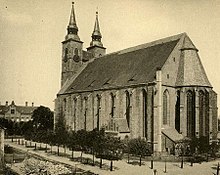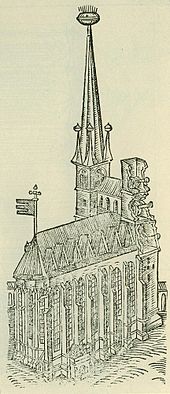St. Jakobi Church (Magdeburg)
The Sankt-Jakobi-Kirche was a church in Magdeburg 's old town . The church was dedicated to Saint James .
location
The church was located at the northern end of Jakobstrasse on the western side of the street, between today's Tränsberg and Blauebeilstrasse . Before the church was built, the gallows of the Magdeburg execution site was located there.
history
The exact date of the laying of the foundation stone is unknown. It is assumed that the foundation stone was laid between 1213 and 1230 under Archbishop Albrecht I von Käfernburg . According to the records of a chronicler, the archbishop is even said to have donated the church. However, this has not been proven either. It was first mentioned in a document on May 13, 1243 .
In 1381 the nave was rebuilt. The reason for this is not known. It is believed that the original building was already too small. The new building then represented the largest parish church in Magdeburg. The south tower of the church is mentioned for the year 1402, as its bell rang for the craftsmen's revolt. At this point the south tower was already finished. At Easter 1438, 57 years after construction started again, the church was vaulted. In 1459 Jakobi rang again the storm to rebellion. The north tower of the church was completed in 1497 by council carpenter Hans Knoche after two years of work.
The church then acquired particular importance as part of the defense of the city in 1550/1551. Under the leadership of Elector Moritz von Sachsen , enemy troops conquered Magdeburg Neustadt and besieged Magdeburg on the night of November 28th to 29th, 1550 . The Magdeburg defenders then brought a cannon onto the north tower of the church on December 10th. Andreas Kritzmann successfully opened fire on the enemy troops. When the fire returned, the church was seriously damaged. Due to the continuous bombardment, the north tower was so damaged that its top was brought to the ground by the Magdeburgers with ropes on the night of February 19-20, 1551. On March 15, the north tower, hung with wool sacks, collapsed. It fell on the church, smashed the vault and seriously damaged the church. The siege, however, was unsuccessful.
On August 21, 1552, a storm tore down the top of the south tower, with the southern part of the church also being badly damaged.
In 1557 a service was held again in the church for the first time. In 1564 the south tower had another, albeit smaller, point, and the last vault was closed.
An organ , which sounded for the first time on August 8, 1568, was installed by the Hamburg organ builders Jacob Scherer and Hans Bockelmann .
The north tower was unchanged in a ruinous condition. From 1581 the tower was rebuilt with considerable support from the magistrate and citizens. The Duke of Braunschweig, Julius , donated the lead (600 quintals) required to cover the tower . The tower was therefore called the Julius hat . It was completed in 1583.
In 1613 lightning struck between the two towers. The heaviest destruction took place during the storming of the city in the Thirty Years' War by troops led by Tilly in 1631. On May 10, Jakobi was the first church to rang the storm because of the enemy attack. However, the fire triggered in connection with the storming destroyed almost the entire city, including Sankt Jakobi. It stayed that way for over seven years; it was not used for the first time until 1638. The remains of the church served as a grain store and threshing floor.
From 1650 the church was rebuilt. On February 15, 1650, master bell founder Jürgen Schreiber cast a new bell for St. Jakobi using the remains of the old molten bell. The rubble was removed from the church between March 1652 and June 1653. A carpenter Linderer erected the towers in 1654, provided them with tower buttons. In 1656 the roof was re-covered and in 1658 the windows were given new panes. On May 10, 1659, the first service took place since the destruction exactly 28 years ago.
In 1844 a floorboard was installed in the church, which increased the floor by 12 cm.
From 1851 to 1906 Hermann Finzenhagen worked as an organist at the Jakobikirche. The Finzenhagen choral society founded by him participated in festive services.
In 1881 the 500th anniversary of the church was celebrated.
During the Second World War , the church was badly damaged in the heaviest air raid on Magdeburg on January 16, 1945 and burned down.
In 1959 the Jakobi Church was blown up and suffered the fate of several other church buildings in Magdeburg (e.g. the Holy Spirit Church ). Many works of art that had been preserved until then (including those by Tobias Wilhelmi ) were still lost.
architecture
Next to the western entrance door on the south side was the inscription: "Na Goddes ghebort MCCCLXXXI des sondages vor palmen do wart de first steyn angelecht to disser kerken" (MCCCLXXXI = 1381).
Stone heads protruded from the south wall of the tower, probably in memory of the former execution site.
In 1902 Magdeburg's city planning officer Otto Peters wrote of a mighty hall structure, slender pillars, clear vaults, a graceful end to the choir vaults and "with the flood of light from the richly decorated windows". He further describes the church as a "richer church building" with "excellent brick porches" on the north and south sides.
Remnants and memories of the St. Jakobi Church
The name of Jakobstrasse and a bronze model on this street at the old location still reminds of the Sankt-Jakobi-Kirche .
Two tombs that are now in the cloister of the Walloon Church have also been preserved. Both were created by the sculptor Tobias Wilhelmi. One epitaph was given to the preacher at the Jakobikirche Christian Scriver (1629–1693), the other to the artillery colonel Jacob Bertram (died May 5, 1697).
literature
- Helene Penner: The Magdeburg Parish Churches in the Middle Ages (Phil. Diss. University of Halle 1919), printed in: Saxony and Anhalt - Yearbook of the Historical Commission for Saxony-Anhalt , 2017, Volume 29, pp. 19-104, here pp. 40– 43.
- Hans-Joachim Krenzke, Churches and Monasteries in Magdeburg , Magdeburg City Planning Office, 2000.
Web links
Coordinates: 52 ° 8 ′ 7.1 ″ N , 11 ° 38 ′ 39.2 ″ E


